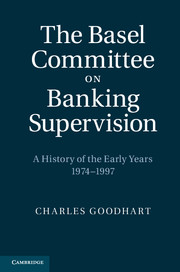Book contents
- Frontmatter
- Contents
- Figures
- Tables
- Foreword
- Preface
- 1 Introduction
- 2 The antecedents of the BCBS
- 3 Modus operandi
- 4 The Concordat
- 5 External and foreign exchange issues
- 6 Capital adequacy and the Basel Accord of 1988
- 7 The Market Risk Amendment
- 8 The Core Principles of Banking Supervision
- 9 Liquidity
- 10 Off-balance-sheet exposures and derivatives
- 11 Other topics addressed by the BCBS
- 12 The relationship of the BCBS with banks and other banking regulators
- 13 Relationships with other non-bank oversight and supervisory bodies
- 14 The legal position of the BCBS
- 15 The international relations of the BCBS
- 16 The BCBS and the social sciences
- 17 Epilogue
- Bibliography
- Index
12 - The relationship of the BCBS with banks and other banking regulators
Published online by Cambridge University Press: 07 September 2011
- Frontmatter
- Contents
- Figures
- Tables
- Foreword
- Preface
- 1 Introduction
- 2 The antecedents of the BCBS
- 3 Modus operandi
- 4 The Concordat
- 5 External and foreign exchange issues
- 6 Capital adequacy and the Basel Accord of 1988
- 7 The Market Risk Amendment
- 8 The Core Principles of Banking Supervision
- 9 Liquidity
- 10 Off-balance-sheet exposures and derivatives
- 11 Other topics addressed by the BCBS
- 12 The relationship of the BCBS with banks and other banking regulators
- 13 Relationships with other non-bank oversight and supervisory bodies
- 14 The legal position of the BCBS
- 15 The international relations of the BCBS
- 16 The BCBS and the social sciences
- 17 Epilogue
- Bibliography
- Index
Summary
Relationship with banks
It is impossible for regulators to do their job without close and continuous contact with the regulated entities, both to obtain basic information and to assess the effects of regulation, both current and prospective, on those being regulated. There is, no doubt, a fine line to be drawn between trying to regulate in an informational vacuum and the regulators ending up in the pockets of the regulated (capture).
But the BCBS itself was, for the most part, freed from having to find this balance, since virtually all direct contact between banks and their supervisors/regulators came via the constituent national supervisors/regulators. As repeatedly noted in earlier chapters, the main source of information and evidence for the BCBS came in the guise of questionnaires constructed by the Secretariat. These would normally be handed over to the BCBS members, who would be responsible for passing them on to an appropriate sample of their own commercial banks, coordinating these responses (so that individual bank confidentiality was maintained) and passing the results back to the BCBS Secretariat, who would then summarise the overall findings.
- Type
- Chapter
- Information
- The Basel Committee on Banking SupervisionA History of the Early Years 1974–1997, pp. 413 - 464Publisher: Cambridge University PressPrint publication year: 2011
- 7
- Cited by



